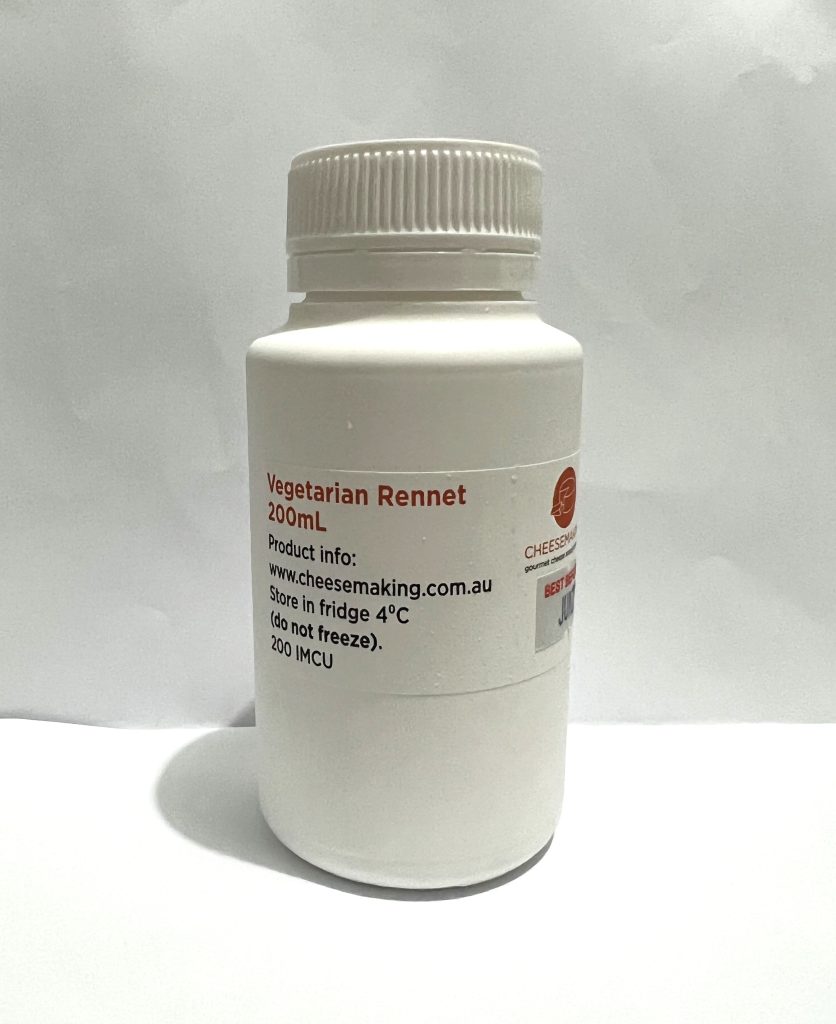- 200 IMCU strength. International Milk Clotting Units is the standard measure of the strength of the rennet.
- The active ingredient is 100% chymosin made from the fermentation of vegetable products by aspergillus niger var awamori.
- This vegetarian rennet can be used for all cheese types.
- Rennet should be used at between 1 mL to 2 mL to 10 litres of milk (volume will vary according to the type of cheese being made and the recipe being used.
- Coagulation, however, is influenced by such factors as seasonal variations affecting milk quality, additions of calcium chloride, pH or acidity variations, and the occurrence of inhibitory agents in the milk.
- Excessive rennet addition or a little bit of extra rennet for good measure should not be practised.
- Rennet is added by drizzling it over the surface of the milk while stirring the milk and then should be stirred in well without aeration for 1 minute. The milk should then be left to rest completely until it is time to cut the curd.
- Store at 0°C – 8°C. Do not freeze this rennet.
- Keep out of direct sunlight.
- Comes in a resealable plastic bottle. If you have a larger bottle consider using a smaller sterile bottle to avoid contamination of the larger solution.
- This rennet contains 18% salt as a preservative, but this salt content will not affect the cheese milk or the starter cultures.
How to add rennet to the milk
- I do not practice the dilution of 200IMCU rennet with boiled cooled water prior to addition to the milk. While this practice is mentioned in many texts, it is a practice developed for high-strength rennet eg where 1,000 IMCU is used or where thousands of litres of milk are used to make cheese. Rennet can be easily mixed into smaller volumes of milk for small commercial manufacturers and home cheesemakers.
- To use 200IMCU rennet without water addition, measure exactly the volume of rennet that you require with a syringe. I prefer to use syringes over mini spoons and teaspoons. The syringes offer excellent accuracy.
- NB: To sanitise, I separate the 2 parts of the syringe, then place them in a clean cup of boiling water for a few minutes, use a pair of tongs to remove the syringes and stand them over the top of the cup to cool down for a few more minutes.
- With syringes used to measure rennet (and other ingredients such as CaCl2, liquid blue mould, annatto), do I allow them to come into contact with any chemical sanitisers eg iodine, chlorine. All chemicals will neutralise the activity of the rennet. After use, separate the syringes and rinse them using the same cup of hot water that sanitised them a few minutes ago. No soap washes.
- Before the addition of the rennet, stir the milk to mix any cream that has risen to the surface, and with the milk still ‘moving/being stirred’, ‘drizzle’ the rennet over the length of the cheese vat.
- Continue stirring very well for another 1 minute.
- At the end of the stir, use the stirrer as a ‘baffle’ to stop the milk from continuing to move. Especially in round vats. Ideally, you want the milk to be as still as possible asap after stirring has been finished.
- Remove the stirrer from the cheese vat and leave the milk to stand completely still.
- Be careful of having a chemical sanitiser running down your hands and into the rennet when you are measuring it out.
- It is recommended that if you purchase a larger volume of rennet, you use a sterile bottle as the working solution, so you do not accidentally contaminate the stock solution.

